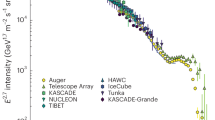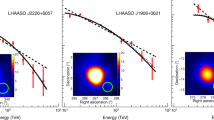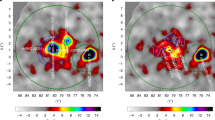Abstract
SINCE the discovery of pulsars and their association with rotating magnetic neutron stars, it has been realised that pulsars can efficiently accelerate particles to high energies and effectively contribute to the observed cosmic-ray density in the Galaxy. Acceleration of particles to very high energies by the low frequency electromagnetic waves beyond the light cylinder is one mechanism proposed1,2. Others3–5 have considered the possibility of accelerating particles by the electric field near the surface of the neutron star arising from nonzero E·B. High energy photons are also likely to be produced in association with these particles and these have been observed from the Crab pulsar. Presumably, younger pulsars may radiate larger numbers of more energetic γ rays.
This is a preview of subscription content, access via your institution
Access options
Subscribe to this journal
Receive 51 print issues and online access
$199.00 per year
only $3.90 per issue
Buy this article
- Purchase on Springer Link
- Instant access to full article PDF
Prices may be subject to local taxes which are calculated during checkout
Similar content being viewed by others
References
Gunn, J. E., and Ostriker, J. P., Astrophys. J., 160, 979 (1970).
Rees, M. J., Nature phys. Sci., 230, 55 (1971).
Komesaroff, M. M., Nature, 255, 612 (1970).
Sturrock, P. A., Astrophys. J., 164, 529 (1971).
Goldreich, P., and Keeley, D., Astrophys. J., 170, 463 (1971).
McBreen, B., Nature, 224, 893 (1969).
Rengarajan, T. N., Proc. eleventh Symposium on Cosmic Rays, Astrophysics, Geophysics, and Elementary Particle Physics, Delhi, India, II, 410 (Delhi, 1969).
Stacker, F. W., and Tsuruta, Nature phys. Sci., 235, 8 (1972).
Apparao, Krishna, and Rengarajan, T. N., Astrophys. Lett., 6, 229 (1970).
Balasubrahmanyan, V. K., Ormes, J. F., and Ryan, M. J., Proc. int. Cosmic Ray Conf., 1, 344 (Hobart, 1971).
Rengarajan, T. N., Proc. int. Cosmic Ray Conf., 1, 350 (Hobart, 1971).
Cameron, A. G. W., A. Rev. Astr. Astrophys., 8, 179 (1970).
Tsuruta, S., Canuto, V., Lodenquai, J., and Rudermann, M., Astrophys. J., 176, 739 (1972).
Rengarajan, T. N., Nature phys. Sci., 242, 103 (1973).
Gould, R. J., and Schreder, G. P., Phys. Rev., 155, 1404 (1967).
Gerasimova, N. M., and Zatsepin, G. J., Sov. Phys. JETP, 11, 399 (1960).
Ormes, J. F., and Balasubrahmanyan, V. K., Nature phys. Sci., 241, 95 (1972).
Webber, W. R., Lezniak, J. A., Kish, J. C., and Damle, S. V., Nature phys. Sci., 241, 96 (1972).
Smoluchowski, S., Nature phys. Sci., 240, 54 (1972).
Author information
Authors and Affiliations
Rights and permissions
About this article
Cite this article
RENGARAJAN, T. Absorption of high energy heavy nuclei and γ rays at the surface of hot neutron stars. Nature 248, 569–571 (1974). https://doi.org/10.1038/248569a0
Received:
Revised:
Issue Date:
DOI: https://doi.org/10.1038/248569a0
This article is cited by
-
Gamma-quanta conversion into positronium atoms in a strong magnetic field
Astrophysics and Space Science (1985)
-
Distance limit for a class of model γ-ray burst sources
Nature (1978)
Comments
By submitting a comment you agree to abide by our Terms and Community Guidelines. If you find something abusive or that does not comply with our terms or guidelines please flag it as inappropriate.



